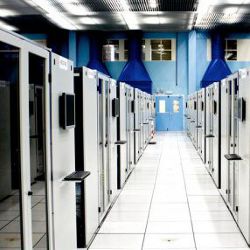
A new study suggests corporations can cut up to 40 percent off their monthly utility bills by using existing Uninterruptible Power Supply (UPS) battery backup devices as an alternative to traditional utility-based power sources for short intervals during peak usage times.
These findings are reported by Pennsylvania State University researchers in "Aggressive Datacenter Power Provisioning with Batteries."
"UPS battery backup devices are not themselves a power source; they will not replace traditional utilities," says Sriram Govindan, who co-authored the paper. "But UPS battery backup is a viable option for power conservation, cost savings, and improvements in green energy sustainability within the next one-to-two years," Govindan says. The Penn State research posits that with careful planning and calculation, datacenters can use UPS battery backup devices to cut capital expenditure costs, significantly reducing ongoing operational expenses from monthly utility bills and making companies more energy efficient.
Datacenters currently spend $10 to $25 per watt to provision their infrastructures; that amount doesn’t decline regardless of the watts the datacenter actually consumes. "Peak power needs rarely arise and so provisioning the power infrastructure for them can be very expensive," Govindan says.
To prove their theory, Govindan and fellow researchers Di Wang, Anand Sivasubramaniam, and Bhuvan Urgaonkar examined stored energy and set up a test lab environment to see what occurs in the immediate aftermath of a power failure. The project was funded in part by National Science Foundation grants and research awards from Google and Hewlett-Packard. The researchers conducted detailed analysis of battery operations to show how a novel knob of energy buffer (eBuff) available in UPS batteries in datacenters delivers significant cost optimization when properly deployed. "Intuitively eBuff stores energy in UPS batteries during ‘valleys’ or periods of lower demand, which can be drained during ‘peaks’ — periods of higher demand," Govindan says.
UPS battery backup devices typically are used as fail-over mechanisms to transition to captive power sources when a utility outage occurs and servers are at risk of going down. However, a lag of a few seconds to a few minutes could occur before a traditional UPS kicks in, which could cause servers to restart and lose the application state. This can disrupt operations in heavy transactional datacenters like brokerages or e-commerce sites, causing the application to time out and lose data. "This is analogous to paying for an insurance premium but not getting the coverage," Govindan says. Disruptions are avoided by the UPS battery, which is provisioned as part of the server’s power supply and takes over immediately with no lag time.
Other organizations, including Google and Akamai, have also evaluated the technique. Govindan says the UPS battery backup approach is straightforward to deploy. It does require some tweaking to let companies invoke them on demand by plugging the servers directly into Power Distribution Units (PDUs). "Once the server is connected to the PDU, the datacenter can use the PDUs to turn off power to a subset of compute equipment, essentially ‘faking’ a power failure to the UPS battery backup, which would deliver power during peak usage times," Govindan says.
Utility companies charge businesses for both the peak power used in a month as well as the overall energy usage, but the peak usage portion of the bill is disproportionately larger. The Penn State researchers compared data from several national utility companies and estimated that datacenters can save up to 40 percent on the total monthly electricity bills by shaving the top 10 percent of peak power consumption. Apart from lowering the utility bill, the UPS batteries can also lower energy consumption, Govindan claims.
"UPS battery backup can hide the peak power from transformers and generators. Whenever power exceeds the transformer or generator’s capacity, use batteries to shave the peak power usage so demand doesn’t exceed the available megawatt," Govindan says.
There are caveats. UPS battery backup devices aren’t cost effective for small businesses. And large enterprises must correctly implement them to realize the benefits.
"The idea has merit but it’s most applicable for mega datacenters and hosting providers," says Andrew Baker, president of Brainwave Consulting, an IT datacenter and security deployment consultancy in Gassaway, W.V. "Firms with fewer than 500 users usually buy a 20-kilowatt UPS battery," Baker says. To accommodate the traditional backup functionality and peak usage scenario, an SMB firm would have to buy a larger, 40-kW UPS battery backup, which has a price differential of $50,000 to $60,000 in capital investment costs. "They wouldn’t see a return on investment for many years," Baker notes. Large enterprises have the flexibility to purchase additional UPS devices of the same size and split the workload.
Enterprises must have enough power and residual capacity for the UPS to perform its original purpose as a backup mechanism.
The Penn State researchers estimated the amount of energy and time the UPS needs to achieve a minimum of up to four "nines" or 99.99% availability in the datacenter. "Our recommendations are that datacenters can safely discharge up to 20 percent of the battery’s charge, twice daily and still have the UPS last for four years," Govindan claims.
[Disclaimer: Comments in this article reflect the personal views of the interviewees only. These views may not reflect the views of other interviewees or affiliated institutions.]
Laura DiDio is principal at ITIC, an information technology consultancy near Boston.



Join the Discussion (0)
Become a Member or Sign In to Post a Comment